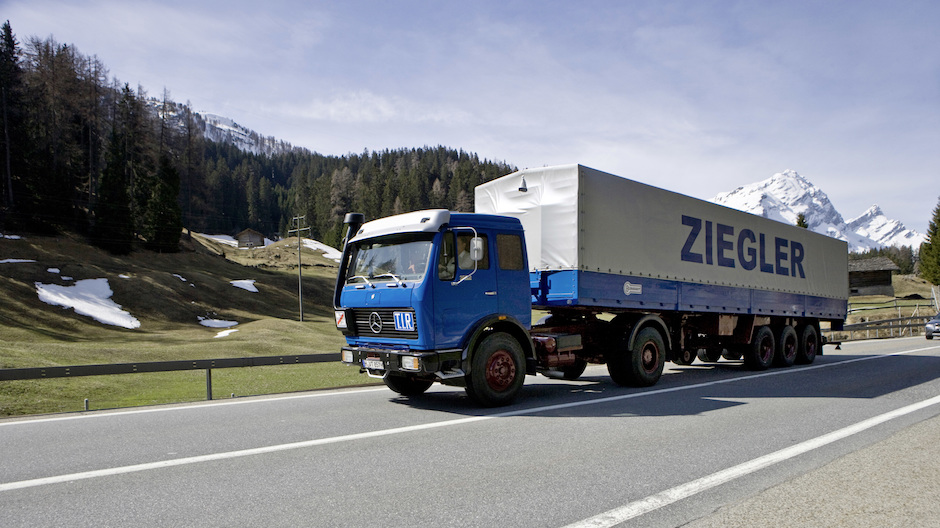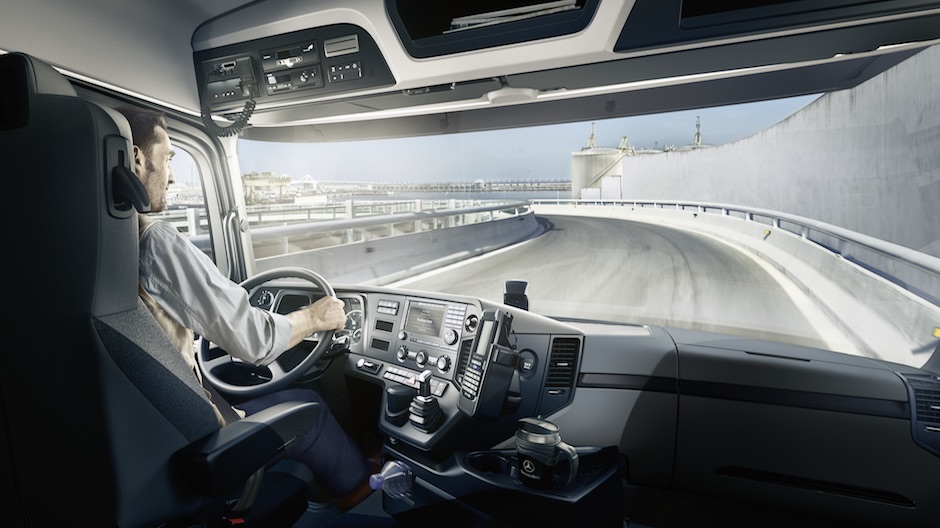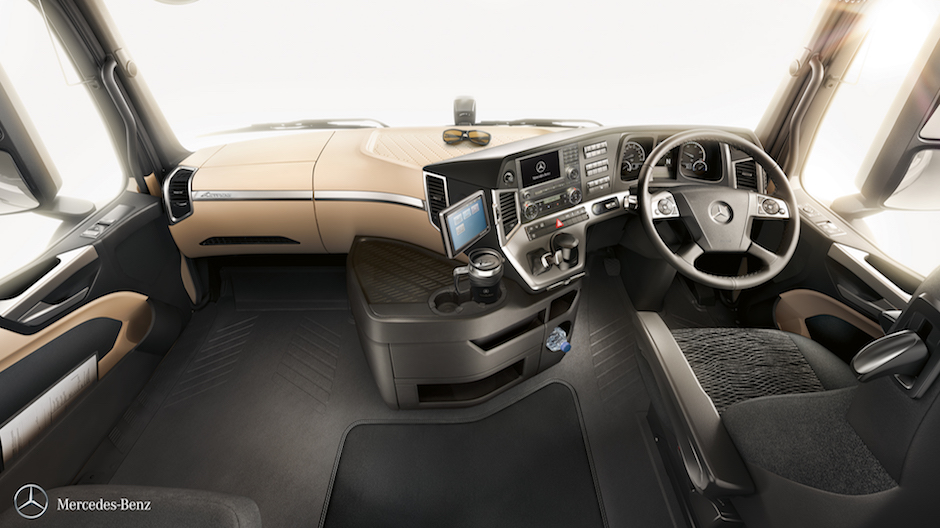
How to get the best from the technology in your truck
TRUCK TECHNOLOGY
Trucks are getting smarter, but that doesn’t mean that drivers can relax. It takes skill and experience to get the best out of your vehicle. No-one knows this better than Bob Beech, truck driver and transport journalist, who has been out on the road for 40 years. Here he shares with us his top tips for making the most of the tech in your truck.

Mercedes-Benz NG 1623 S from the 1970s
Way back when…
I started driving trucks back in the 1970s, working for a family transport business, a world far removed from today’s industry. The trucks were vastly different, with a far less power, more noise and a lot less comfort. Journey times were slower and sat-nav and mobile phones were non-existent.
The driver was in complete control of all vehicle functions, judging time and distance, synchronising engine revs and gearshifts, making careful use of the truck’s limited braking capability and allowing for deficiencies of the suspension and steering systems. This required looking well ahead and keeping up momentum (because the relative lack of engine power and torque meant that it took far longer to get up to cruising speed), while constantly keeping a close eye on the gauges, listening to the engine and heading off trouble before it began. In effect, the truck told you what it needed, and you made it happen.

Interior of a Mercedes-Benz NG 1632 S from the 1970s
Smarter vehicles, smarter drivers.
Modern electronic systems monitor virtually the complete operation of the vehicle. Banks of ECU’s, fed by sensors, are continually adjusting the performance of the vehicle. It can at times seem a little uninvolving, but a well-trained driver can have a significant impact on the overall performance of the truck.
Take care with cruise control.
Planning ahead, reading the road and traffic flow, is second nature to an experienced driver, but imparting this information to the truck is the clever bit. Modern systems are only as good as the quality of the information received, and even the latest adaptive cruise controls that read the road ahead of the truck cannot always deal with our crowded roads, unless the driver input is at the right level. For example, a distraction such as an accident on the opposite carriageway of a busy motorway often causes the traffic travelling in the other direction to slow suddenly. No electronic system can spot that happening, but an alert driver will see it and take avoiding action.

Mercedes-Benz Antos interior
No need to struggle with automated gearboxes.
Modern automated gearboxes are now very popular – some younger drivers will never have driven a truck with a manual gearbox! The transmission software and speed of response has improved considerably since the first versions went into service back in the 90s, but we still see drivers struggling in certain situations. Here are a few examples:
· Low-speed manoeuvring can cause problems. If the truck has a low-speed crawler function in both forward and reverse, but it is not used, this will result in poor clutch response, making the truck lurch as the engine’s revs rise. Remember to check you’re using the right function and also consider dumping the air suspension from either a pusher or tag axle if fully laden, as this reduces scrub and resistance as the clutch takes up drive.
· When slowing at a roundabout, if the engine brake is not used correctly, the truck comes to a standstill in a relatively high gear and often remains in that gear until the throttle is used to pull away. The gearbox is then confused and takes a while to sort itself out. Remember to use the engine brake, telling the transmission that the truck might well be coming to a standstill and it should change down accordingly. If the truck stops, a gentle tap on the throttle will prime the gearbox to pick the right starting gear, and it will be ready to pull away as soon as a gap appears in the traffic.
· Using the hill hold function helps in these situations, it allows you to sense the clutch biting point especially on an uphill gradient. All too often we hear drivers complain that the truck tries to roll back when they try a hill start just using the handbrake. The answer is activating the button on the dashboard with the brake symbol – it’s easy when you know how.

Mercedes-Benz Actros interior
Vehicle telemetry versus engine braking.
Effective secondary braking systems are an integral part of modern truck. They allow a well-trained driver to preserve the main wheel brakes for the greater part of most journeys. This reduces wear on brake discs and pads, keeping them cool and potentially at their most efficient in case of emergency. It also reduces the amount of heat transmitted to the tyres, wheel bearings and other components.
Ironically some driver trainers and large fleets discourage drivers from using modern engine brakes in the very situations they are designed for. Many operators use vehicle telemetry to monitor both vehicle performance and driver behaviour. The use of high engine revs will impact fuel consumption when the engine is under load, in situations such as climbing a hill or accelerating. A modern engine brake has no impact on fuel use because the engine is not firing, there is no fuel injected, it is just working as a great big compressor. Some aftermarket telemetry systems do not make this distinction and drivers find themselves disciplined for driving the truck the correct way when colleagues who sail down hills using the footbrake to hold the truck back receive a gold star. Fortunately, modern EBS disc brakes are very efficient and can withstand more of this type of abuse than old style drum brakes, but the maintenance costs are far higher, and the truck is off the road for longer as a result.
Try some DIY driver training.
The answer to any of these issues is practical driver training when drivers take over a new truck. Sadly, it is not always provided. The good news is that all of this information is contained in the vehicle handbook. If there is one in your truck, next time you have a few spare minutes why not take a look, you might be surprised by how much you can learn!



Comment
Please log in to post a comment.
9 comments
Thank you for your reply/comments to my post. We are in accord with drivers, however as I have said getting drivers to 'accept' that they need to adapt/change their driving style is not easy. Indeed boss's very often don't push it for fear of aggravation from drivers, even though the end result may well be beneficial to the company.
I recall one incident where by a driver had problems with his Actros & he flat out argued with me over the phone that the lorry "wasn't as good as his old SK because there was no emergency shift" in the truck. After a brief argument I handed the phone back to my boss & walked off.Can you see the point I am making. Mercedes like all manufacturer's are continually improving ideas & tech, but as I have stated, I have to wonder if the effort is worth it in a sense. I now work in environmental business & I am pushing for a fleet of Econics because my brief experience with these trucks (although I have been with Mercs for years) has been superb. Extremely reliable with minimal down time & a pleasure to drive, whilst being modestly economical so reading articles on here among others I want our firm to make the right choice, but having spoken to my boss he fears like me the lorry might be 'too much' for the lion's share of our drivers & the product wont reflect Mercedes great product as a result.
I am still going to push for the change though & hope we can make headway with the drivers, but time will tell. Once again, thank you for your interest in my reply. Peter Elvins.
Thank you for your reply/comments to my post. We are in accord with drivers, however as I have said getting drivers to 'accept' that they need to adapt/change their driving style is not easy. Indeed boss's very often don't push it for fear of aggravation from drivers, even though the end result may well be beneficial to the company.
I recall one incident where by a driver had problems with his Actros & he flat out argued with me over the phone that the lorry "wasn't as good as his old SK because there was no emergency shift" in the truck. After a brief argument I handed the phone back to my boss & walked off.Can you see the point I am making. Mercedes like all manufacturer's are continually improving ideas & tech, but as I have stated, I have to wonder if the effort is worth it in a sense. I now work in environmental business & I am pushing for a fleet of Econics because my brief experience with these trucks (although I have been with Mercs for years) has been superb. Extremely reliable with minimal down time & a pleasure to drive, whilst being modestly economical so reading articles on here among others I want our firm to make the right choice, but having spoken to my boss he fears like me the lorry might be 'too much' for the lion's share of our drivers & the product wont reflect Mercedes great product as a result.
I am still going to push for the change though & hope we can make headway with the drivers, but time will tell. Once again, thank you for your interest in my reply. Peter Elvins.
Hope you both have a good Christmas. Simon
Hope you both have a good Christmas. Simon
I hope you have a very merry Christmas, as well!
I hope you have a very merry Christmas, as well!
To get the best out of today’s vehicles an element of re-learning is needed and as the average age of truck drivers continues to rise (as a 50 year old I class myself in this group!) technology is a constant wave of change (much like learning to best operate the latest mobile phone, tablet or indeed car!)
We, Bob and I, were talking with a driver the other day, reminiscing about trucks of the 80’s and 90’s, we laughed and congratulated their history, but none of us would want slide back and daily drive the vehicles we cut out teeth in.
Simon
To get the best out of today’s vehicles an element of re-learning is needed and as the average age of truck drivers continues to rise (as a 50 year old I class myself in this group!) technology is a constant wave of change (much like learning to best operate the latest mobile phone, tablet or indeed car!)
We, Bob and I, were talking with a driver the other day, reminiscing about trucks of the 80’s and 90’s, we laughed and congratulated their history, but none of us would want slide back and daily drive the vehicles we cut out teeth in.
Simon
I drive for a Mercedes-Benz main dealer and know first hand what a complete delight these trucks are to drive especially when you take the time to learn with them and appreciate their functions, having been a driver for thirty years I have certainly experienced some vehicles in their day, I am pleased to say I do now drive the very best.
Regards
Kevin Parr.
I drive for a Mercedes-Benz main dealer and know first hand what a complete delight these trucks are to drive especially when you take the time to learn with them and appreciate their functions, having been a driver for thirty years I have certainly experienced some vehicles in their day, I am pleased to say I do now drive the very best.
Regards
Kevin Parr.
are designed to take a skilled professional driver and demonstrate, via both interactive classroom and driven on-road demonstrations, the benefits of adding and combining driver skill and technology. Keep up the good work.
Simon
are designed to take a skilled professional driver and demonstrate, via both interactive classroom and driven on-road demonstrations, the benefits of adding and combining driver skill and technology. Keep up the good work.
Simon
I am pushing for our company to change over to a fleet of Econics, but This very topic worries me as I know that the lorry is probably going to be too clever for the drivers.
Still It's a good article & well worth noting, so thanks for posting it.
I am pushing for our company to change over to a fleet of Econics, but This very topic worries me as I know that the lorry is probably going to be too clever for the drivers.
Still It's a good article & well worth noting, so thanks for posting it.